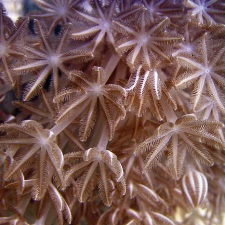Can Coral Save Our Oceans?

Coral reefs are home to a rich and diverse ecosystem, providing a habitat for a wide range of marine animals. But the increasing acidification of ocean water is jeopardizing the calcified foundations of these reefs, endangering the survival of thousands upon thousands of resident species.
New research by Prof. Yehuda Benayahu, Dr. Zehava Barkay, Prof. Maoz Fine, and their jointly supervised graduate student Yasmin Gabay of Tel Aviv University's Department of Zoology, Wolfson Applied Materials Research Center and the Interuniversity Institute for Marine Sciences in Eilat has uncovered the protective properties of soft coral tissue, which proved resilient when exposed to declining oceanic pH levels. The study, published in PLOS One, provides insight into the changing face of coral reefs threatened by dropping oceanic pH levels and may provide a new approach toward preserving the harder, calcified reef foundations.
Reefs and environmental change
Acidification is caused by increased carbon dioxide emissions in the atmosphere due to global change, fossil fuel burning, and other pollution. These emissions dissolve in the ocean, resulting in a slight lowering of oceanic pH levels. This produces changes to ocean water's carbon content, destroying the calcification of reef-building stony coral.
“The rise in temperature and ocean acidification are the main concerns of environmental change,” said Prof. Benayahu, the Israel Cohen Chair in Environmental Zoology, whose TAU laboratory is home to one of the world's only soft coral (octocoral) research centers. “We know the value of reefs, the massive calcium carbonate constructions that act as wave breakers, and protect against floods, erosion, hurricanes, and typhoons. While alive, they provide habitats for thousands of living organisms, from sea urchins to clams, algae to fish. Reefs are also economically important in regions like Eilat or the Caribbean.”
At first, the researchers examined the effects of lowered pH levels on living colonies of soft corals. Observing no significant effects on their physiology, Gabay thought it would be interesting to consider the effects of acidification on the skeleton of these soft corals.
“We really wanted to know if something could survive dropping pH levels in the future,” said Gabay. “I was curious as to whether coral tissue could protect the inner coral skeleton, which is of most use in terms of reef construction, so I conducted an experiment using live soft corals and soft coral skeletons, which were placed in tanks containing ocean water with manipulated pH levels.”
Using state-of-the-art microscopy, Gabay then scanned the tissue-covered skeletons and bare skeletons of soft corals exposed to experimental acidic conditions, the same conditions the International Panel of Climate Change predicts will occur 100 years from now if carbon dioxide emissions continue to rise. She found that the bare soft coral skeletons exhibited acidic stressed symptoms — large pockets burned into their microscopic corpuscular subunits — whereas the tissue-covered skeleton revealed almost no damage to its microscopic subunits.
“We found that the soft coral's tissue may indeed protect the skeleton from declining pH levels,” said Yasmin Gabay. “The organism's internal environment apparently has a mechanism that protects against the acidic conditions.”
The future of “the orchestra”
According to Prof. Benayahu, the future of soft-coral reefs is still unclear. Soft corals are not primary reef builders, because their skeletons are slow to calcify. Stony corals provide the massive skeletons that create reefs. Soft corals are replacing these reef builders, because they are somehow able to survive and live under extreme environmental conditions.
“A reef is like an orchestra. Many organisms interact to create harmony,” said Prof. Benayahu. “Thousands of species live together and create life together. It is hard to predict what will happen if only soft corals survive, because they simply do not calcify at same rate as stony corals.”
The researchers are currently studying the potential effects of soft coral displacement of stony coral species and the subsequent ramifications for reefs.
Media Contact
All latest news from the category: Ecology, The Environment and Conservation
This complex theme deals primarily with interactions between organisms and the environmental factors that impact them, but to a greater extent between individual inanimate environmental factors.
innovations-report offers informative reports and articles on topics such as climate protection, landscape conservation, ecological systems, wildlife and nature parks and ecosystem efficiency and balance.
Newest articles

Long-sought structure of powerful anticancer natural product
…solved by integrated approach. A collaborative effort by the research groups of Professor Haruhiko Fuwa from Chuo University and Professor Masashi Tsuda from Kochi University has culminated in the structure…

Making a difference: Efficient water harvesting from air possible
Copolymer solution uses water-loving differential to induce desorption at lower temperatures. Harvesting water from the air and decreasing humidity are crucial to realizing a more comfortable life for humanity. Water-adsorption…

In major materials breakthrough
UVA team solves a nearly 200-year-old challenge in polymers. UVA researchers defy materials science rules with molecules that release stored length to decouple stiffness and stretchability. Researchers at the University…



